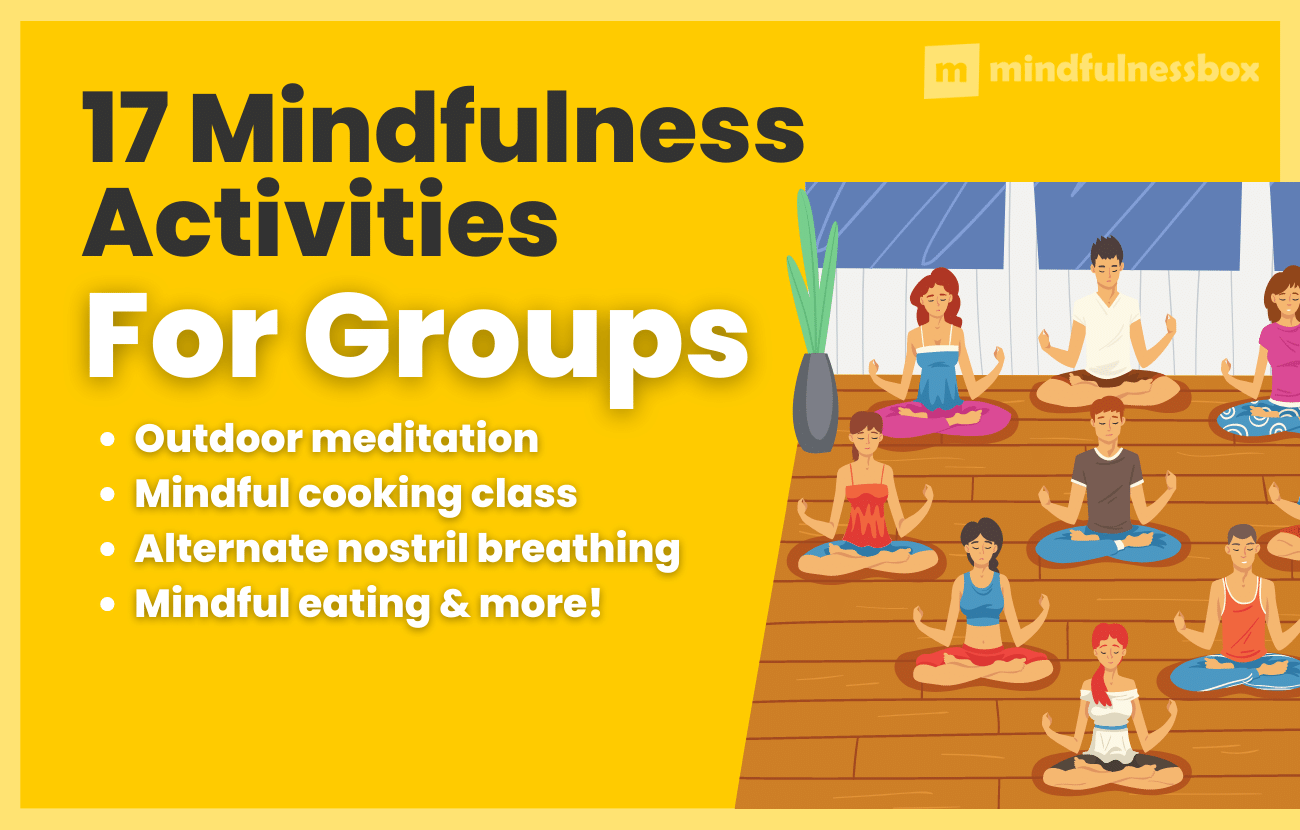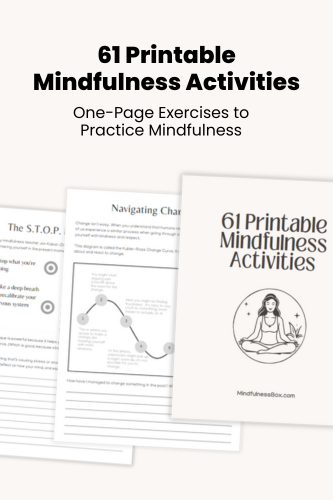There’s way more variety to group mindfulness activities than the seated meditation, group yoga, and gratitude lists that most of us first think of. From outside meditation to group hugs to mindful cooking classes, the options for mindful group exercises are endless.
When you’re designing mindfulness activities for groups, it can be hard to know where to start because of how diverse the topic is.
Do you stick to meditation only?
How do you incorporate “mindfulness,” anyway?
How do you break up your mindfulness sessions so they don’t get too boring?
Get dozens of one-page exercises to help practice mindfulness, meditation, gratitude, and self love. Perfect for printable handouts when teaching mindfulness to groups, students, or in the workplace.
To see examples, plus a full list of the 61 exercises included, click below.
The trick with group mindfulness activities is to include a mix of pensive, thought-provoking activities along with more interactive, playful activities.
Whether you’re looking for fun mindfulness activities for groups, mindfulness games for groups, or mindfulness team building activities, this list is designed to help you mix and match activities of different length and different intensity.
The end result? A set of mindfulness activities that has an impact on your group long after the session is over.
Let’s jump in.
17 Mindfulness Exercises for Groups
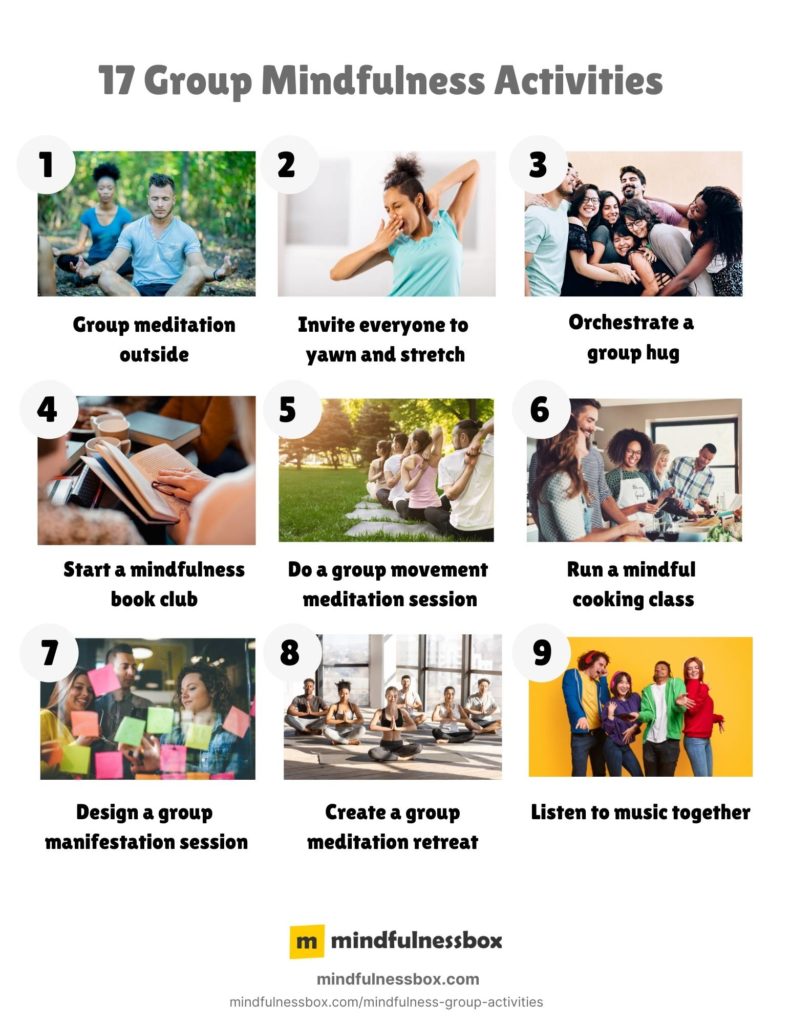
1. Bring your group to meditate outside
If you’re looking for unique meditation ideas for groups, meditating outside is a great place to start.
It’s great for rewiring your expectations about meditation. Meditation doesn’t require silence. It’s not easy, but instead of focusing on your breath, try keeping an open awareness, absorbing whatever sounds come up in your environment.
Next time you’re considering a meditation activity for a group, try bringing them outside – even if it’s a bit noisy.
Of course, if the jackhammers start, you might have to put headphones on, or head back inside. But if you’re in a place with peaceful nature sounds or even just normal city noises, you might find that meditating on the sounds of your environment adds a new angle to your mindfulness practice.
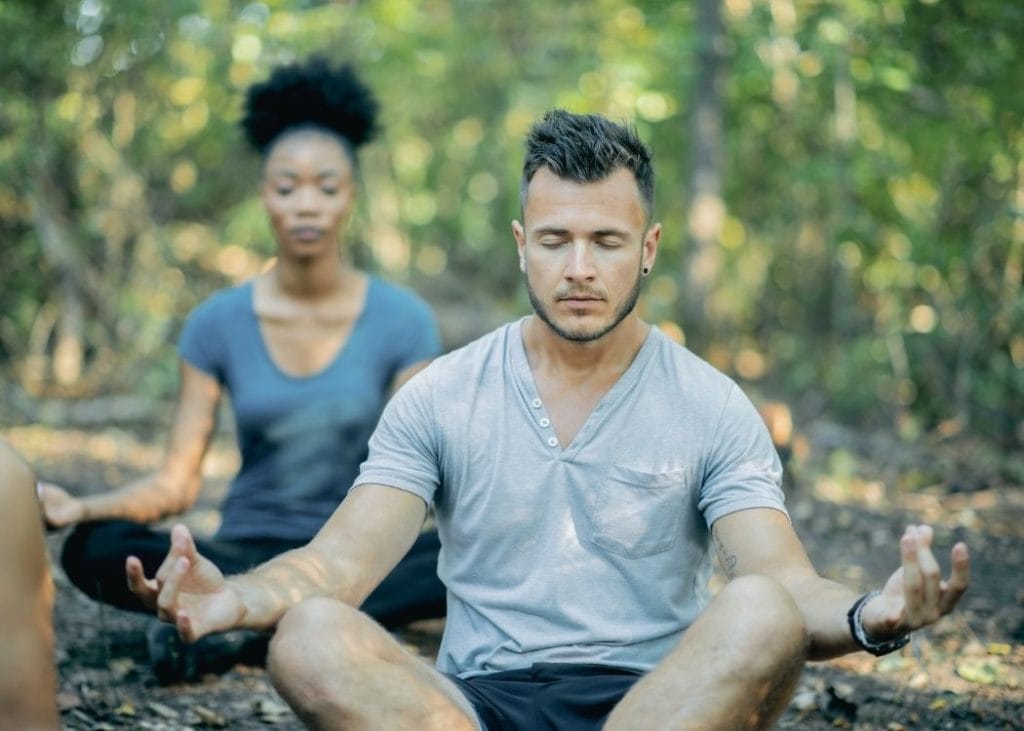
2. Invite your group to yawn and stretch
Who doesn’t appreciate an opportunity to yawn and stretch?
Especially if you’re designing a group mindfulness activity that takes place in the morning, try opening your session with an invitation to yawn and stretch. There’s no better icebreaker than to give everyone a chance to do what they really want to do:
Acknowledge the fact that they’re tired!
Yawning and stretching (slowly) is also a mindfulness exercise on its own. It brings you back to your body, and helps you release areas of tension.
3. Orchestrate a group hug
Of course, this depends on how comfortable your group is with each other. But it can be a great exercise, whether as a group hug or a series of 1:1 hugs with people who are comfortable with each other.
Hugging can help you remind yourself of the strength of the mind-body connection. Often, when you’re stuck in a cycle of negativity, more thinking won’t solve the problem – but moving your body and connecting with others can help.
Invite your hug partner to take three deep breaths while hugging you, in order to balance your nervous system and release oxytocin.
4. Start a mindfulness book club
It’s incredible what you can learn from the writings of the great spiritual teachers.
From the Dalai Lama to Jon Kabat-Zinn to Thich Nhat Hanh, the knowledge of the wisest people who’ve ever lived is at your fingertips.
Consider starting a mindfulness book club to read inspiring books and talk through them together. If anyone in the group wants to make a change based on what they’re reading, you can support each other with accountability.
Want some recommendations? Check out my list of the best mindfulness books.
5. Do a group movement meditation session
Did you know you don’t have to sit still on a cushion in order to meditate?
Many people forget this.
That’s why if you’re designing a group mindfulness session that includes a lot of sitting, you’ll want to consider adding in some movement meditation, too.
Try experimenting with tai chi, qi gong, dancing, walking meditation, or other forms of movement meditation. Movement meditation can be a wonderful way to start team mindfulness activities because of how interactive it is.
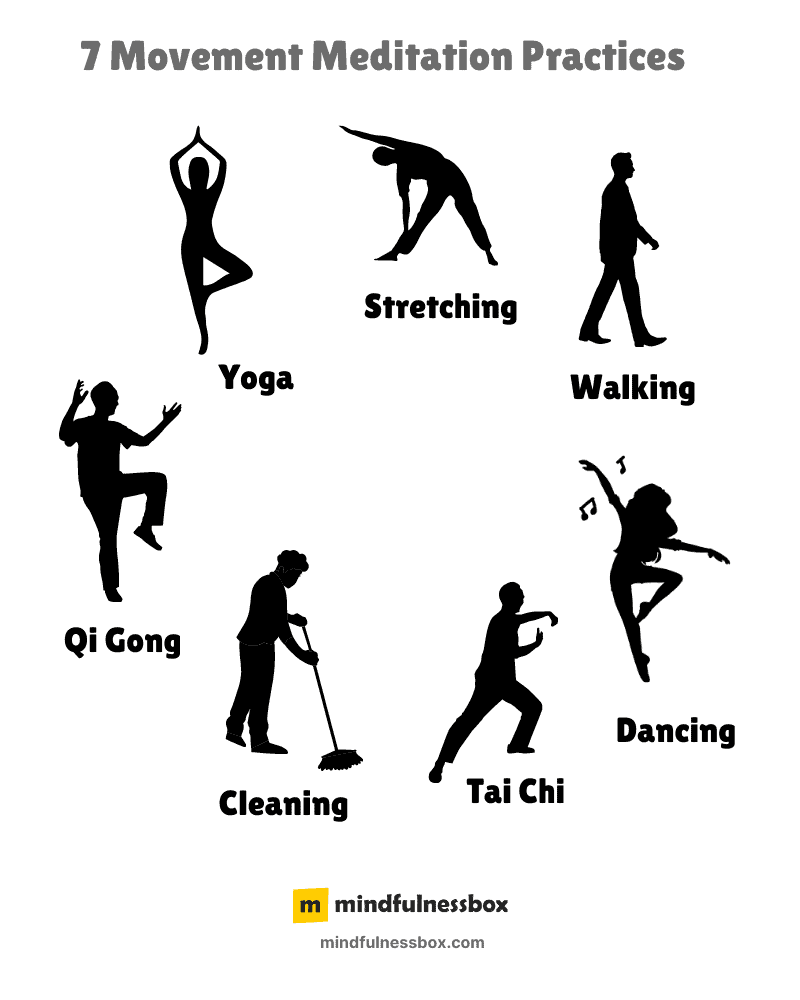
6. Run a mindful cooking class
Mindful cooking is a way to bring yourself deeply into the act of chopping ingredients and cooking your meal. As a bonus, it helps you build patience and makes the whole cooking process more enjoyable. That’s what makes it one of the best interactive group mindfulness activities.
If anyone in your group finds themselves getting stressed or overwhelmed while cooking, they might be getting lost in thought instead of losing themselves in the present moment.
A group mindful cooking class can help internalize this present-moment orientation during cooking, so participants can apply them while making future meals.
Here’s a list of mindful cooking strategies for mindful cooking class.
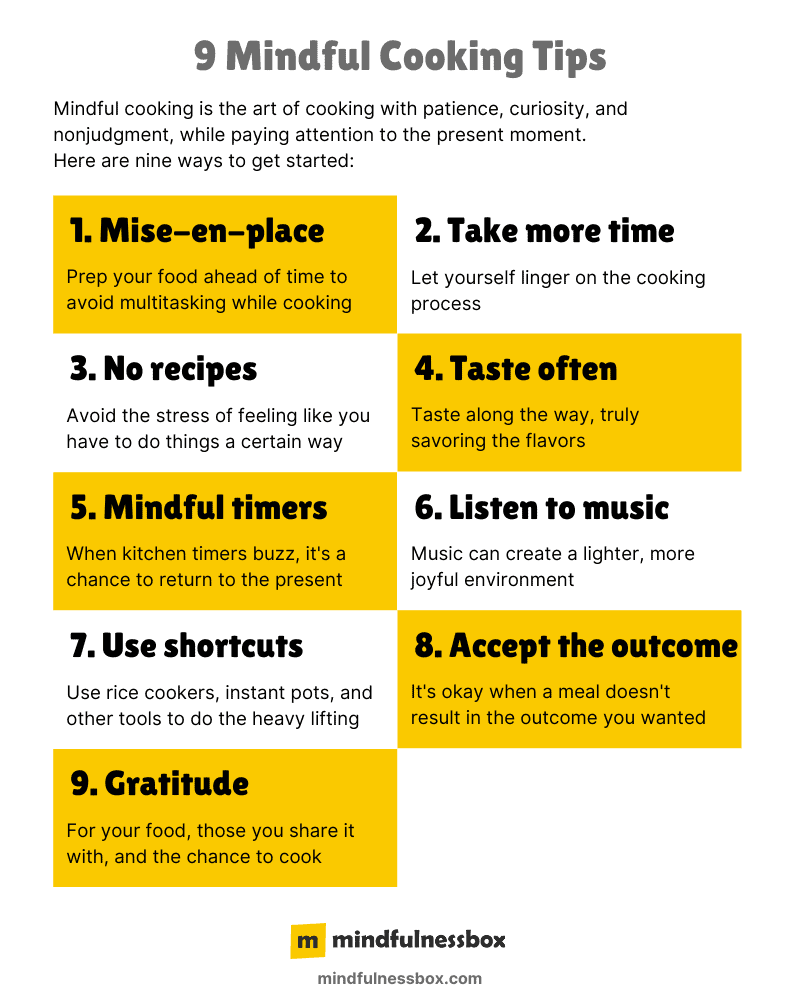
7. Design a group manifestation session
In one group manifestation session I participated in, each person took time to imagine what they wanted their life to look like in a year, in vivid detail. Then, we were matched up with a partner and described our vision for ourselves out loud.
It was a powerful experience, and made even more powerful by the fact that our visions were shared with the group.
Manifestation might seem a little woo-woo if you haven’t tried it, but as I argue in my manifestation guide for skeptics, it’s essentially a supercharged version of traditional goal setting.
Rather than just giving yourself a goal, manifestation invites you to dream big, then create a detailed, emotional, and immersive visualization that makes it feel like you’ve already achieved what you set out to do. In a way, you’re hacking your mind’s expectations to pave the road that allows you to reach your goals.
8. Create a group meditation retreat
You don’t have to do a ten-day silent meditation retreat like I did, but a group meditation retreat of one day or more offers the opportunity to get much more meditation practice than you would normally.
Think of it this way: if you meditate for ten minutes each day, that means you get 60 hours of meditation practice in a year. At a retreat, you’re likely to get that much practice in a week.
Consider incorporating group meditation sessions in your next retreat as a way to help participants advance their practice and provide a burst of motivation to continue further on their own.
9. Listen to music together
What does it mean to mindfully listen to music?
You just need to bring your full awareness to whatever you’re listening to. When your attention drifts, bring it back to the present moment and the experience of listening to each layer of sound.
This activity is easy to do incorporate into group relaxation activities to build mindfulness. Just give “mindful listening” instructions, pick a song, and play it. You may want to play the song once without instructions, and then play it again after giving instructions, so participants can try to dive deeper into paying attention to the sounds, chords, instruments, and vocals.
Wearing headphones and listening to a song that’s entirely new to you are a couple of ways to make it easier to listen to music mindfully.
10. Find a way for your group to be playful
As we grow into adulthood and responsibilities feature more prominently in our lives, some of the playfulness of childhood naturally seeps out.
That’s why helping adults find a way to be playful is one of the quickest ways to not only loosen up a group activity, but to help participants have fun and connect to their inner child and their most authentic selves.
If you’re looking for a quick framework for thinking about mindfulness, approaching life with a playful, childlike attitude is a great place to start.
11. Invite your group to try negative visualization
Counterintuitively, negative visualization is a way to appreciate what you have.
Here’s how it works. Imagine yourself at some point in the future, having lost everything you hold dear. Maybe you don’t have a job, or you’ve ended up alone, or you’ve encountered any number of challenging scenarios.
Then, zoom back out and return to your present self. Notice all the good that’s around you. Use the contrast of the negative visualization with your present experience as a way to build gratitude and appreciation.
The way to approach this activity with a group is to have them write down their negative visualization privately, and then share what they’re comfortable with sharing. Some of the details of their negative visualization exercise may be private, so some people may feel comfortable sharing only how it made them feel to return to their present experience after the exercise.
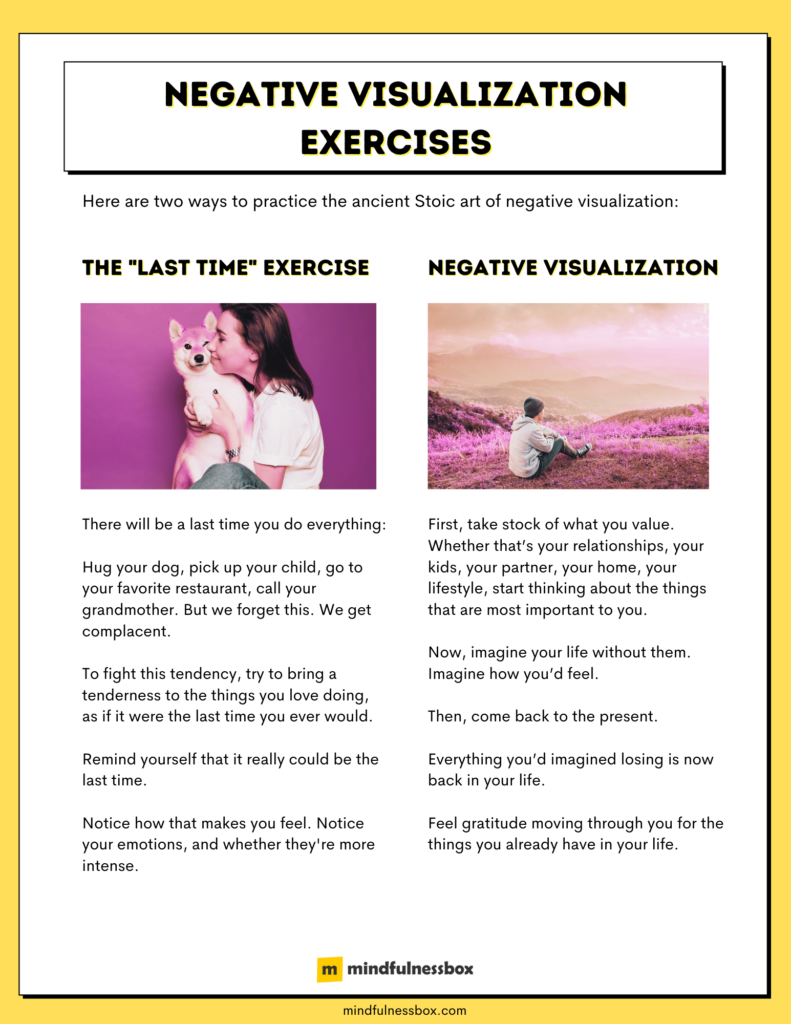
12. Curate your group’s social media feeds with mindfulness content
Do you ever find that the immediate aftermath of a group activity is powerful, but as time goes on, that feeling slips away?
It’s a natural part of the process. One of the easiest ways to introduce mindfulness into your participants’ lives on an ongoing basis is to make the process automatic for them with social media.
Doing a “social media audit” during your group mindfulness session can influence your thinking, because the accounts you follow decide the content that fills your mind each day. Invite your participants to make sure the accounts that populate their social feeds contain the kind of thinking and examples that they want to bring into their lives.
Remove those that don’t, and add more accounts that do. Over time, they’ll automatically be exposed to and reminded of key mindfulness concepts.
You can follow Mindfulness Box’s social media channels here. While you’re at it, follow some of these other excellent mindfulness resources.
13. Bring a dog to play with your group
That’s right – when it comes to mindfulness, Fido is one of the foremost experts out there.
While humans are all about striving, animals easily achieve the present-moment awareness we’re after – and they do so effortlessly.
Consider bringing a dog to spice up your meditation exercises for groups. Invite your group to notice the playfulness and joy that they approach each moment with. Notice the dog’s lack of focus on the past and future.
Dogs make us happier, reduce stress, remind us to practice mindfulness, and demonstrate that it’s indeed possible to focus on the present. So, when in doubt – play with your dog.
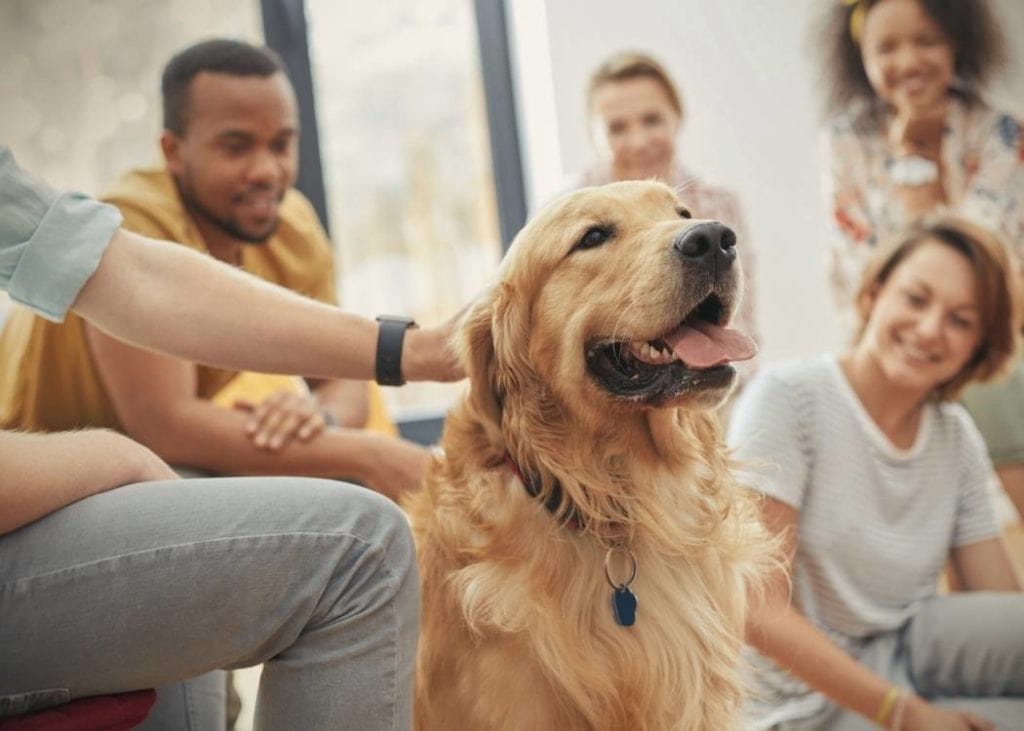
14. Practice mindful eating together
If your group will be eating a meal or even a snack together, consider mindful eating. Eating often becomes an automatic process for many of us. But it can be a mindful experience instead.
Here’s how you can instruct your group:
While eating, try and gently stop yourself if you notice you’re eating on autopilot. Then, shift your attention. Try slowing down, and paying attention to the texture and flavor of the food and drink. Take a piece of food and savor it. Noticing how it tastes and smells. Notice how the meal feels as you slow down and pay attention.
15. Practice box breathing as a group
Breathing exercises are a classic group mindfulness activity. Box breathing is part breathing technique, part visualization exercise. It’s simply another approach towards holding your attention onto an object of concentration, as a way to practice staying in the present moment while calming your nervous system.
Because of the effect box breathing has on calming your nervous system, it can be a good start to mindfulness group therapy activities.
To start, visualize the left side of a two-dimensional square. Inhale to the count of 4. As you inhale, move along the left side of the square towards the top of the square, in your mind’s eye.
Then, hold your breath for 4 seconds, heading towards the right side of the square. Exhale for 4 seconds, heading down the right side of the box. Finally, hold for another 4 seconds at the bottom of the box, before starting the process again.
16. Help your group learn alternate nostril breathing
When you’re in need of a quick group mindfulness activity, alternate nostril breathing is good because it’s easy to understand (and sparks a little curiosity, because – “We’re doing what with our nostrils, now?).
Alternate nostril breathing provides a great structure to help you manage your breath, while regulating the nervous system and promoting relaxation.
To get started, just place your thumb on your right nostril. Then, breathe slowly through the left nostril. Switch to the other nostril, and repeat the process 3-4 more times.
17. Go barefoot and explore together
A great way to shake your group out of your typical routine, and into a new way of looking at the world, is to go barefoot.
First of all, having your whole group go barefoot is just plain fun. When everyone takes their shoes off and starts moving around, it brings a new kind of energy into the room.
But more importantly, intentionally observing the world while barefoot can be a great mindfulness activity. This is especially true for those who have trouble with sitting meditation. Walking barefoot is a way to focus on sensations you normally wouldn’t notice.
To get started, have participants take their socks and shoes off and walk around on the carpet or floor. What feelings do they notice? Is there any other surface they can step on? How does it compare? Have them wiggle their toes, move their feet, and really feel the surface of the ground as they slowly pay attention to the experience of walking in a deeper way than before.
Download these group mindfulness exercises
Interested in downloading all of these activities as a printable PDF?
Just click the button below:

My mindfulness practice kicked off in 2016 with a ten-day silent retreat. Since then, I’ve read dozens of books about mindfulness and completed hundreds of hours of meditation. Thinking about what makes humans happy, calm, and peaceful is endlessly fascinating to me.

